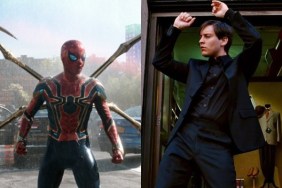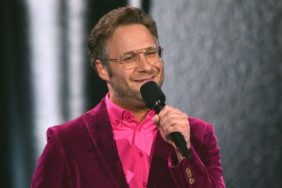Way, way back at the beginning of CraveOnline‘s Free Film School (the world’s best film school in the world), I – your humble professor – gave a lecture on the notion of spacial continuity. To give a brief recap: spacial continuity is essentially a movie’s ability to ensure the viewer knows where, in physical and geographical space, the action is taking place. A film with very strong spacial continuity will give a viewer a sense as to how far apart the characters are from one another, how quickly things move, or how big the monsters are. As the name implies, you’ll know the space within the universe of the movie.
I bring it up, because since I wrote that lecture, trends have continued in an alarming way. The notion of spacial continuity, as was also brought up in a 2011 article on IndieWire, seems to be on the decline, and the author of that article has taken to calling this new aesthetic trend of deteriorating clarity “chaos cinema.” The famed film scholar David Bordwell had also been noticing American films’ tendency toward faster editing, louder noise, and a much quicker and busier aesthetic for many years, but he used the far more egalitarian phrase “intensified continuity” to describe the phenomenon.
I agree with many of the theories in the IndieWire article, and I’m fond of their phrase, so I figured I would perhaps give my own spin on the concept, and lecture you a bit more on how important clarity is in filmmaking. Because, dammit, it’s important.

Back in April, Steven Spielberg’s 1993 film Jurassic Park was re-released in theaters, complete with a new 3-D imprimatur. Watching the film, I found that it not only held up as a stellar entertainment, but was also possessed of a more leisurely pace, a more static camera, and a more deliberately staid visual style than many of the blockbusters of more a more recent vintage. That Jurassic Park still works so well, and that it was so strikingly different from its peers pointed out several things about the way filmmaking has evolved since.
One: It proved that Spielberg was a master of craft and pacing when it came to exciting genre entertainments (but this, we knew). Two: It proved that older cameras were harder to move, and kept a lot of the filmmakers on their toes in terms of setting up shots and lighting, framing characters, framing action, and editing sparingly. Three: It proved that newer films are trending more and more away from this carefully-planned and static aesthetic toward something noisier and faster and faster and faster.
There is a great line of dialogue from the very good but not-often-referred-to 1952 showbiz drama The Bad and the Beautiful that illustrates a salient point. In that film, Kirk Douglas plays a sinister movie producer who uses business acumen to make a string of hits for his friends and for the studios he works for. He also routinely stabs his peers in the back, ousting them and betraying them with no moral qualms. There is a scene in the film wherein Douglas is hectoring a hard-working film director. The director is shooting a dinner scene, and Douglas is insisting that the shots he has selected aren’t dazzling enough. I’m paraphrasing here, but the director lays it out bare for his producer something like this: “If I did what you ask, every shot in my film would be a climax. It would make the shot exciting, but it would make me a bad director.”

The recent trend in action movies, you may have noticed, it toward the every-shot-as-a-climax aesthetic. The camera is shaking more, the editing is more and more rapid, the angles change with greater frequency, and it’s all the viewer can to to hang on or make sense of anything. Directors like Michael Bay and Zack Snyder are at the vanguard of the movement, but they are not the only ones. This comes, I think, from an increasing fear of silence, and a decreasing faith in audience attention spans. It’s not enough that each action blockbuster be good. It has to outdo the last one. We’ve pushed blockbuster aesthetics to such an extreme degree that it’s fast approaching abstract nonsense.
This has been a problem of mine for many years, and I trust that some of you, my dear students, know what I’m talking about. There was a time when action scenes were magnificently choreographed and planned and staged. Think of a good kung fu fight, or, comparably, a good long dance number. The camera kept its distance, didn’t edit frequently at all (sometimes allowing the fight/dance to play out for minutes at a time), and allowed the audience to make sense of everything on the screen.
Now, all too often, you’ll find films like the Transformers films, or Man of Steel, and sense an aesthetic urgency. The camera never stops moving. Everything is handheld. This approach can lend an immediacy and sometimes even an intimacy to a scene or even to a whole movie, but when it’s all you’re doing, then you’re doing something wrong. We’ve reached the point wherein action is no longer an exciting series of events used to reach a catharsis or plot point, and more a longer, louder jumble of movement. This is not just boredom with the notion of The Big Fight (i.e. the story’s conflicts end with a battle, which can also wear on a filmgoer), but an observation on how we’ve almost reached a breaking point in the way action is made.

This could be a blip, and the lamentable observations of chaos cinema could just be the way films are made these days; film must evolve as the technology to make it does. But we, as filmgoers, film experts, filmmakers, and film critics, need to desperately understand the way action can and should be used in movies, and how it should be depicted. We need to constantly recall, especially in the new days of fast-and-loose handheld ultra-edited chaos, that spacial continuity is perhaps the first and most important rule. Something I value, and something all filmgoers value, is clarity. Visual clarity. That’s all we ask for. A noisy mess of images does not equal excitement. At best, it can offer distraction.
If we try to make every shot a climax, then, well, we’ll just be bad at movies.
Homework for the Week:
Think of an action sequence that you would film. How would you film it? How many times would you think would be good to edit? How close would you be to the action? What are your favorite movie action sequences? What made them your favorites? Could they have benefited from more editing? From less? Do you like shaky cameras, or still ones?
Witney Seibold is a featured contributor on the CraveOnline Film Channel, co-host of The B-Movies Podcast and co-star of The Trailer Hitch. You can read his weekly articles Trolling, Free Film School and The Series Project, and follow him on “Twitter” at @WitneySeibold, where he is slowly losing his mind. If you want to buy him a gift (and I know you do), you can visit his Amazon Wish List.








